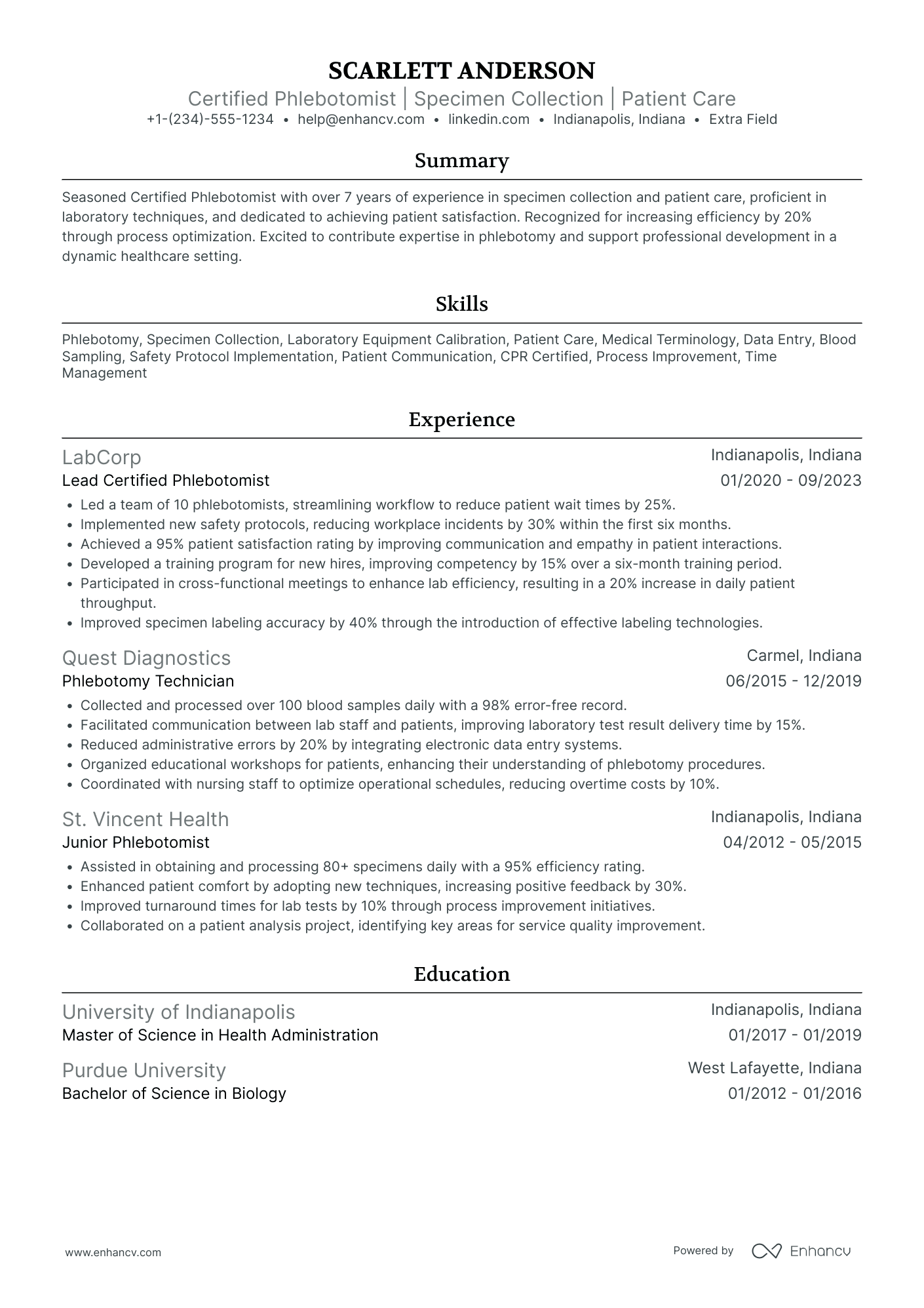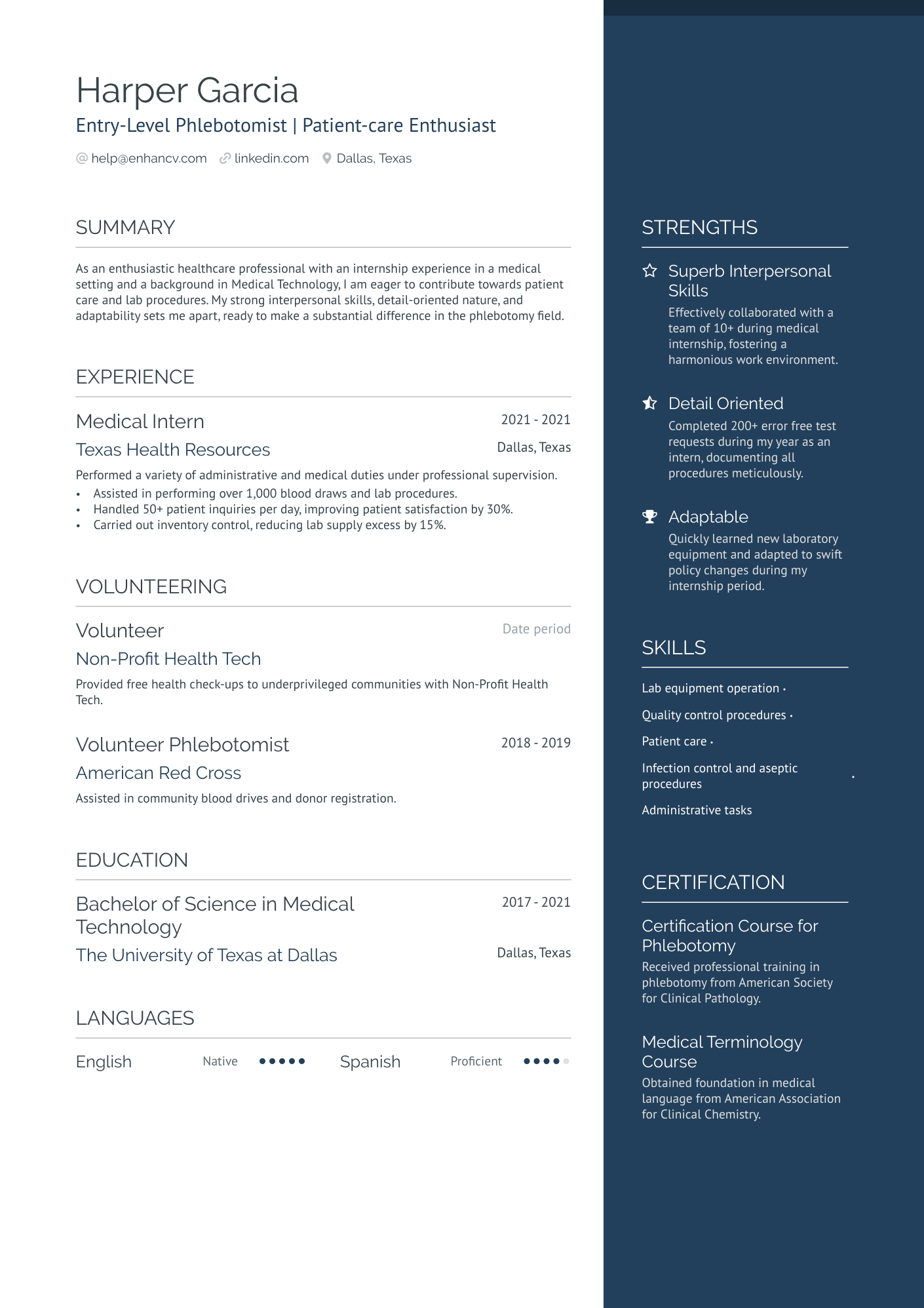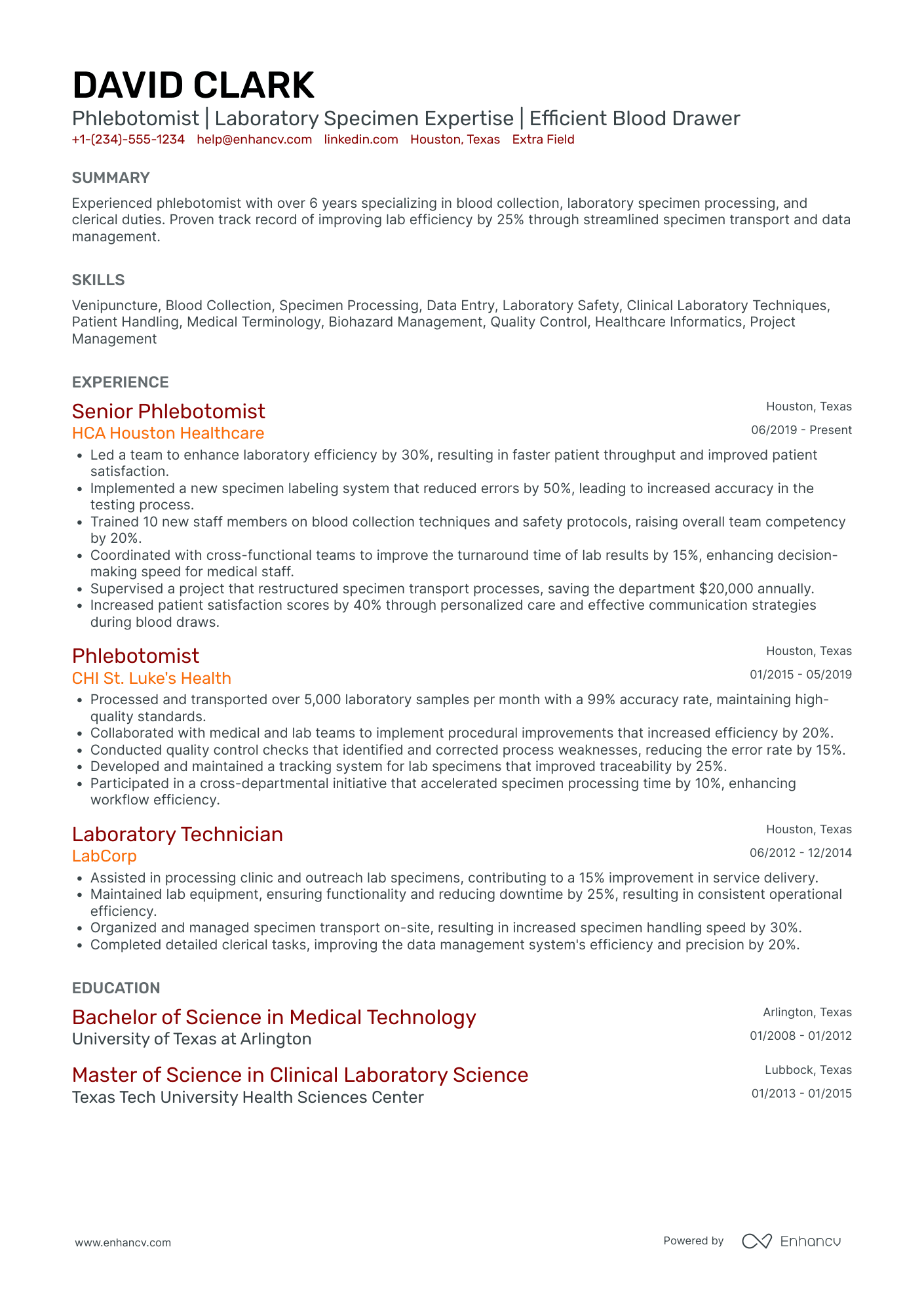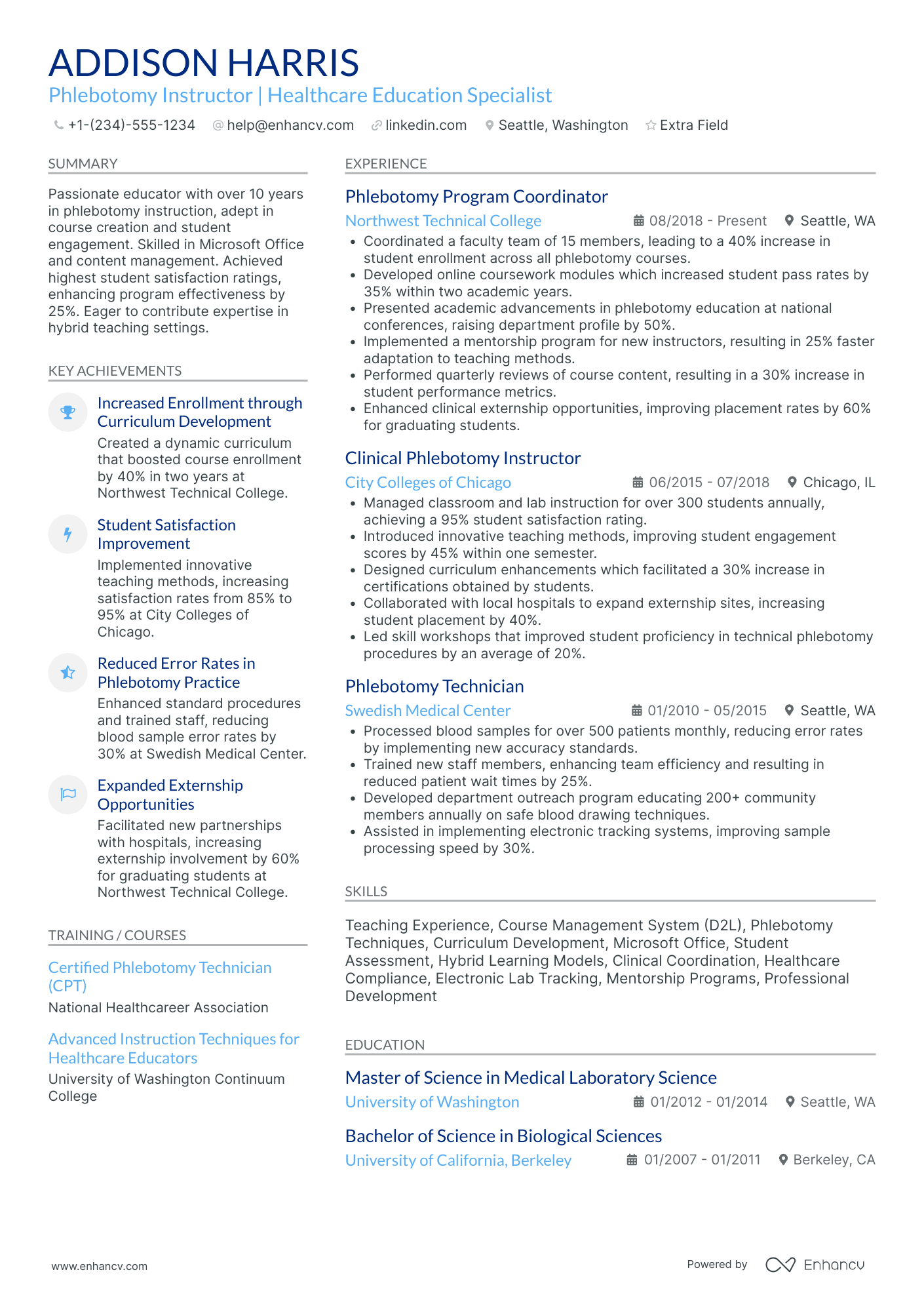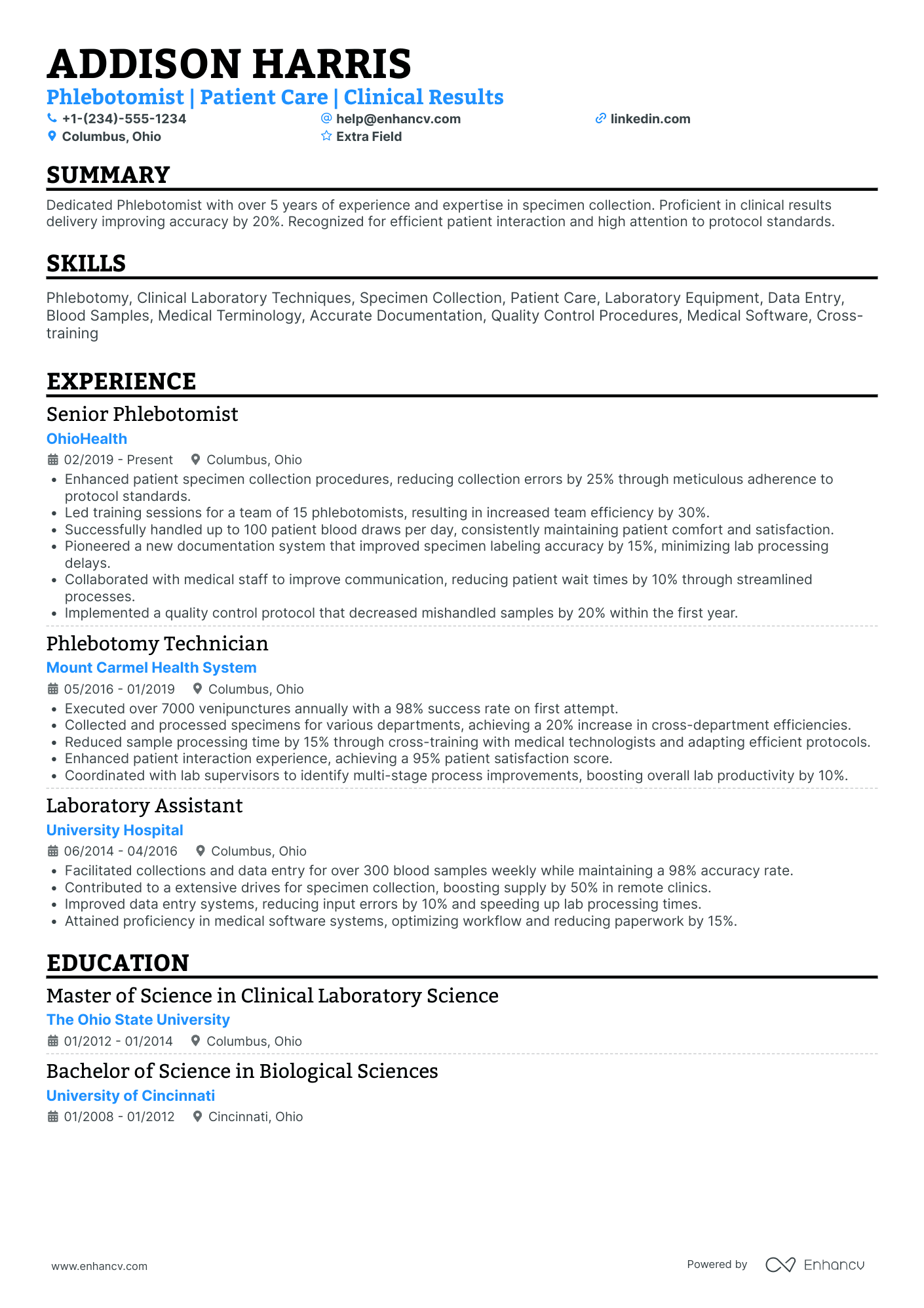As a phlebotomist, you may struggle with detailing your hands-on experience in venipuncture and patient interaction on your resume. Our guide offers tailored advice on articulating your technical skills and bedside manner, ensuring your application stands out to prospective employers.
- Sample industry-leading professional resumes for inspiration and phlebotomist resume-writing know-how.
- Focus recruiters' attention on what matters most - your unique experience, achievements, and skills.
- Write various resume sections to ensure you meet at least 95% of all job requirements.
- Balance your phlebotomist technical expertise with personality to stand out amongst candidates.
If the phlebotomist resume isn't the right one for you, take a look at other related guides we have:
- Clinical Nurse Manager Resume Example
- Nurse Recruiter Resume Example
- Public Health Resume Example
- Occupational Therapist Resume Example
- Massage Therapist Resume Example
- Social Worker Resume Example
- Babysitter Resume Example
- Certified Nurse Aide Resume Example
- ICU Nurse Resume Example
- Infection Control Nurse Resume Example
Optimize your phlebotomist resume format to pass the recruiters' assessment
You may be wondering just how much time you need to spend on designing your phlebotomist resume.
What recruiters are looking for is systematised content that is clear and coherent. Thus, your phlebotomist resume needs to answer requirements and why you're the best candidate for the role from the get-go.
Often, a clear layout consists of:
- Sorting your experience in the reverse chronological order - starting with your most recent and relevant roles. This is an excellent choice for more experienced professionals;
- Writing your contact information (e.g. personal phone number and email address) and your portfolio or LinkedIn link in your phlebotomist resume header. If you're wondering to include a photo or not, always make sure that it's appropriate for the country you're applying in;
- Use the basic, most important phlebotomist resume sections - your experience, education, summary, etc. Use your resume's real estate wisely to tell a compelling, professional story and match job description's keywords;
- Don't go overboard with the length of your resume. One page is absolutely fine if you happen to have under a decade of relevant experience.
Are you still wondering if you should submit your phlebotomist resume in PDF or Word format ? The PDF has a few more advantages, as it doesn't change the format and the text can't be altered upon application.
Format matters most when your phlebotomist resume is assessed by the Applicant Tracker System (or the ATS).
The ATS parses resumes, looking for specific keywords, skills or experience that match the job description.
P.S. We recently did a study on how the ATS works and were able to demystify three of the biggest misconceptions about how it assesses candidate resumes.
To pass the ATS evaluation, select any of the serif or sans-serif fonts. Popular choices that would help your phlebotomist resume stand out include Raleway, Exo 2, Montserrat, etc.
Most traditionalists go for Arial or Times New Roman, but it's often the case that many candidates choose these fonts, and you'd thus lose points on the uniqueness front.
Consider the local standards – Canadian resumes, for example, may have a different format.
Upload & Check Your Resume
Drop your resume here or choose a file. PDF & DOCX only. Max 2MB file size.
PRO TIP
If you happen to have plenty of certificates, select the ones that are most applicable and sought-after across the industry. Organize them by relevance to the role you're applying for.
The six in-demand sections for your phlebotomist resume:
- Top one-third should be filled with a header, listing your contact details, and with a summary or objective, briefly highlighting your professional accolades
- Experience section, detailing how particular jobs have helped your professional growth
- Notable achievements that tie in your hard or soft skills with tangible outcomes
- Popular industry certificates to further highlight your technical knowledge or people capabilities
- Education to showcase your academic background in the field
What recruiters want to see on your resume:
- Proficiency in various blood collection techniques (such as venipuncture, butterfly, and capillary collection)
- Knowledge of proper specimen handling and processing
- Experience in working with a wide range of patients, including pediatric, geriatric, and difficult veins
- Understanding of safety protocols and infection control measures
- Strong interpersonal and communication skills for patient interaction
Advice for your phlebotomist resume experience section - setting your application apart from other candidates
Your resume experience section needs to balance your tangible workplace achievements with job requirements.
The easiest way to sustain this balance between meeting candidate expectations, while standing out, is to:
- Select really impressive career highlights to detail under each experience and support those with your skills;
- Assess the job advert to define both the basic requirements (which you could answer with more junior roles) and the more advanced requirements - which could play a more prominent role through your experience section;
- Create a separate experience section, if you decide on listing irrelevant experience items. Always curate those via the people or technical skills you've attained that match the current job you're applying for;
- Don't list experience items from a decade ago - as they may no longer be relevant to the industry. That is, unless you're applying for a more senior role: where experience would go to demonstrate your character and ambitions;
- Define how your role has helped make the team, department, or company better. Support this with your skill set and the initial challenge you were able to solve.
Take a look at how real-life phlebotomist professionals have presented their resume experience section - always aiming to demonstrate their success.
- Consistently collected and processed over 30 blood samples per day, maintaining a 99% accuracy rate, thereby reducing the re-collection rate by 15%
- Implemented a patient-centric approach that decreased patient anxiety and discomfort, leading to a 20% increase in positive customer feedback
- Participated in a cross-functional team that developed a new labeling system, cutting down processing time by 25% and reducing mislabeled specimens
- Trained 10 new phlebotomy technicians, resulting in a more efficient and knowledgeable staff, ultimately increasing department productivity by 30%
- Led mobile blood drives, coordinating with 20+ events annually and collecting over 2,000 units of blood critical for hospital supply
- Spearheaded a quality control initiative, dramatically reducing sample contamination by 12% and ensuring higher integrity of laboratory results
- Expertly collected blood specimens from 40-50 patients daily, utilizing advanced venipuncture and capillary puncture techniques
- Enhanced patient record-keeping procedures by integrating a digital tracking system, which improved efficiency by 22% and reduced clerical errors
- Collaborated on the implementation of an in-house training module, leading to standardized practices across the organization and improved compliance with safety regulations
- Pioneered a peer review program that brought about greater adherence to internal protocols and an 18% increase in overall procedural compliance
- Played a pivotal role in acquiring AABB accreditation by maintaining immaculate phlebotomy stations and perfecting sample collection processes
- Facilitated the transition to a new electronic health record system that expedited data retrieval times by 35%, significantly boosting productivity
- Streamlined the blood collection process, reducing average patient wait times by 20 minutes and enhancing the overall patient experience
- Coordinated with a team to develop a waste reduction protocol, effectively cutting down biohazard material disposal by 40%
- Conducted over 5,000 successful blood draws with minimal need for re-draws, maintaining patient safety and satisfaction
- Improved blood specimen handling protocols, ensuring a 10% increase in the integrity of samples delivered to the lab for analysis
- Developed bilingual instructional materials for patients, resulting in improved preparatory compliance and a 50% reduction in procedural errors among non-English speakers
- Mastered electronic medical record systems, achieving a 98% proficiency level and becoming the go-to resource for staff
- Orchestrated the collection and processing of over 20,000 blood samples, ensuring timely delivery to corresponding departments for critical diagnostic testing
- Acted as a liaison between phlebotomy and laboratory teams, fostering a collaborative environment that improved testing turnarounds by 24%
- Received recognition as 'Employee of the Year' for exceptional diligence and dedication to maintaining high standards in patient care
- Integrated a new barcoding system for specimen tracking that reduced mislabeling incidents by 95% across the facility
- Organized quarterly training workshops for continuous education, ensuring the team is up-to-date with the latest phlebotomy techniques and regulations
- Introduced ergonomic workstations that enhanced employee well-being and reduced work-related muscle strain by 60%
- Revamped the donor experience in the plasma collection center, leading to a 40% increase in repeat donors over a two-year period
- Implemented safety protocols that saw a 25% reduction in needlestick injuries, significantly improving the working conditions for staff
- Efficiently managed inventory of phlebotomy supplies, avoiding stock shortages and saving the department an estimated $5,000 annually
- Executed blood draws with a commitment to patient comfort, receiving a 96% satisfaction rate in post-visit surveys
- Contributed to a departmental project focusing on turnaround times, achieving a 20% improvement in the delivery of test results to physicians
- Advised on the purchasing of new phlebotomy equipment, optimizing budget spend and supporting a 15% increase in daily patient throughput
The following content includes information from "O*NET OnLine" by the U.S. Department of Labor, Employment and Training Administration (USDOL/ETA). Used under the CC BY 4.0 license. The data represents the top responsibilities present on the task lists for phlebotomist professionals.
Top Responsibilities for Phlebotomist:
- Dispose of contaminated sharps, in accordance with applicable laws, standards, and policies.
- Organize or clean blood-drawing trays, ensuring that all instruments are sterile and all needles, syringes, or related items are of first-time use.
- Draw blood from veins by vacuum tube, syringe, or butterfly venipuncture methods.
- Dispose of blood or other biohazard fluids or tissue, in accordance with applicable laws, standards, or policies.
- Conduct standards tests, such as blood alcohol, blood culture, oral glucose tolerance, glucose screening, blood smears, or peak and trough drug levels tests.
- Collect specimens at specific time intervals for tests, such as those assessing therapeutic drug levels.
- Enter patient, specimen, insurance, or billing information into computer.
- Draw blood from capillaries by dermal puncture, such as heel or finger stick methods.
- Conduct hemoglobin tests to ensure donor iron levels are normal.
- Transport specimens or fluid samples from collection sites to laboratories.
Quantifying impact on your resume
- Include the number of successful blood draws performed to demonstrate proficiency and experience in venipuncture.
- Specify the percentage of first-attempt venipuncture successes to showcase efficiency and patient comfort.
- List the volume of blood collected over a period to illustrate the ability to handle a high workload.
- Quantify the number of patients served per day to highlight capacity to work in a fast-paced environment.
- Detail the rate of complication-free procedures to emphasize a strong track record of safety and accuracy.
- Mention the percentage decrease in patient wait times due to workflow improvements you implemented.
- Provide statistics on the number of new phlebotomists you trained or mentored to establish leadership skills.
- Document any increase in patient satisfaction scores related to your phlebotomy services to reflect quality of care.
Action verbs for your phlebotomist resume
What if my phlebotomist experience doesn't match the requirements?
You've just graduated from college and may have no real world job experience . What should you include within your resume then?
Instead of making up information or adding irrelevant past jobs (e.g. your on-campus work during freshman year), you can:
- Shift the focus from your professional experience to your community impact with your volunteer work. This would showcase numerous soft skills you've built over time (e.g. interpersonal communication);
- Highlight the projects you've completed, as part of your coursework, or, on your own. Thus, you will align your technical background with recruiters' requirements;
- Consider spotlighting your transferrable skills. Or, what lessons and talents your current professional and personal experience has taught you and how they could benefit your potential employers;
- Even if you've had a few months of internship experience, that is relevant for the role, make sure to include this. Recruiters do care about the years of experience you happen to have, but, at the end of the day, your profile would also be assessed based on role alignment.
Recommended reads:
PRO TIP
List all your relevant higher education degrees within your resume in reverse chronological order (starting with the latest). There are cases when your PhD in a particular field could help you stand apart from other candidates.
Phlebotomist resume skills section: writing about your hard skills and soft skills
Recruiters always care about the skill set you'd bring about to the phlebotomist role. That's why it's a good idea to curate yours wisely, integrating both hard (or technical) and soft skills. Hard skills are the technology and software you're apt at using - these show your suitability for the technical aspect of the role. They are easy to track via your experience, certifications, and various resume sections. Your soft skills are those personality traits you've gained over time that show how you'd perform in the specific team, etc. Soft skills are more difficult to qualify but are definitely worth it - as they make you stand out and show your adaptability to new environments. How do you build the skills section of your resume? Best practices point that you could:
- Include up to five or six skills in the section as keywords to align with the advert.
- Create a specific technical skills section to highlight your hard skills aptitude.
- Align the culture of the company you're applying to with your soft skills to determine which ones should be more prominent in your skills section.
- Make sure you answer majority of the job requirements that are in the advert within your skills section.
A phlebotomist's resume requires a specific skill set that balances both industry-specific hard skills with personal, soft skills. Discover the perfect mix for the phlebotomist role from our list:
Top skills for your phlebotomist resume:
Venipuncture techniques
Capillary puncture techniques
Use of needle and collection tubes
Knowledge of blood collection protocols
Experience with blood sample labeling
Familiarity with laboratory information systems (LIS)
Sterilization techniques
Infection control practices
Knowledge of anatomy and physiology
Ability to operate blood collection equipment
Effective communication
Attention to detail
Empathy and compassion
Strong organizational skills
Ability to work under pressure
Problem-solving skills
Interpersonal skills
Time management
Adaptability
Teamwork
Next, you will find information on the top technologies for phlebotomist professonals from "O*NET OnLine" by the U.S. Department of Labor, Employment and Training Administration (USDOL/ETA). Used under the CC BY 4.0 license.
Top technologies for Phlebotomist’s resume:
- Medical procedure coding software
- MEDITECH Laboratory and Microbiology
- Microsoft Excel
- Microsoft Outlook
PRO TIP
Always remember that your phlebotomist certifications can be quantified across different resume sections, like your experience, summary, or objective. For example, you could include concise details within the expertise bullets of how the specific certificate has improved your on-the-job performance.
Certifications and education: in-demand sections for your phlebotomist resume
Your academic background in the form of certifications on your resume and your higher degree education is important to your application.
The certifications and education sections pinpoint a variety of hard and soft skills you possess, as well as your dedication to the industry.
Add relevant certificates to your phlebotomist resume by:
- Add special achievements or recognitions you've received during your education or certification, only if they're really noteworthy and/or applicable to the role
- Be concise - don't list every and any certificate you've obtained through your career, but instead, select the ones that would be most impressive to the role
- Include the name of the certificate or degree, institution, graduation dates, and certificate license numbers (if possible)
- Organize your education in reverse chronological format, starting with the latest degree you have that's most applicable for the role
Think of the education and certification sections as the further credibility your phlebotomist resume needs to pinpoint your success.
Now, if you're stuck on these resume sections, we've curated a list of the most popular technical certificates across the industry.
Have a look, below:
The top 5 certifications for your phlebotomist resume:
- Certified Phlebotomy Technician (CPT) - National Healthcareer Association (NHA)
- Phlebotomy Technician Certification (PBT) - American Society for Clinical Pathology (ASCP)
- Registered Phlebotomy Technician (RPT) - American Medical Technologists (AMT)
- Nationally Registered Certified Phlebotomy Technician (NRCPT) - National Association of Phlebotomy Professionals (NAPP)
- Certified phlebotomist (CPhT) - National Phlebotomy Association (NPA)
The content below includes information from "O*NET OnLine" by the U.S. Department of Labor, Employment and Training Administration (USDOL/ETA). Used under the CC BY 4.0 license. The data represents the top associations for phlebotomist professionals.
Top US associations for a Phlebotomist professional
- American Medical Technologists
- American Society for Clinical Pathology Board of Certification
- National Center for Competency Testing
- American Society for Clinical Pathology
- American Society of Phlebotomy Technicians
PRO TIP
Listing your relevant degrees or certificates on your phlebotomist resume is a win-win situation. Not only does it hint at your technical capabilities in the industry, but an array of soft skills, like perseverance, adaptability, and motivation.
Recommended reads:
The phlebotomist resume summary or objective: integrating keywords, achievements, and more
Deciding whether to include a resume summary or an objective in your phlebotomist resume is crucial. Both serve as key introductory elements at the top of your resume, encapsulating your profile in up to five sentences and incorporating relevant keywords from the job advert.
Here are the key differences between the two:
- The resume summary focuses on aligning your achievements and experience with the job requirements. It provides recruiters with a snapshot of your expertise, helping you stand out as an ideal candidate for the role.
- The resume objective, on the other hand, centers on your career goals and aspirations, detailing how the role aligns with your career progression. It's particularly suitable for candidates with less professional experience or those new to the job market.
Below are examples demonstrating best practices in utilizing the resume summary and/or objective to make a strong first impression with your phlebotomist resume.
Resume summaries for a phlebotomist job
- Focused, adaptable medical professional with 5 years of experience as a phlebotomist; proficient in venipuncture, capillary techniques, and patient care. Distinguished for consistently achieving high patient satisfaction rates and maintaining meticulous sample integrity that led to a 15% reduction in cross-contamination incidents.
- Compassionate and quality-focused phlebotomist bringing over 7 years of experience in fast-paced hospital settings and outpatient labs. Demonstrated success in implementing blood-draw protocols that enhanced patient comfort, receiving commendations for a 20% decrease in procedure-related patient anxiety.
- Customer service expert with 8 years in retail management, now transitioning to healthcare, seeks to leverage exceptional people skills and attention to detail. Driven to excel in patient interactions as a phlebotomist, using my refined communication abilities to ensure patient ease and procedure clarity.
- Meticulous electrical engineer seeking to apply a decade of technical expertise and problem-solving acumen to a new career in phlebotomy. Eager to contribute an analytical mindset and precision in protocol adherence, ensuring high-quality specimen collection for accurate diagnostic results.
- Eager to embark on a rewarding career in phlebotomy with no prior experience in the field, but equipped with a strong foundation in biology and a passion for helping others. Aim to leverage my academic knowledge and volunteer experience in patient care to excel in sample collection and patient interaction.
- As a recent graduate with a certification in Phlebotomy, I am ready to take my theoretical knowledge and hands-on training to provide excellent patient care and efficient specimen processing. Determined to apply my fresh perspective and enthusiasm to contribute to a team focused on superior healthcare services.
Average salary info by state in the US for phlebotomist professionals
Local salary info for Phlebotomist.” Source: My Next Move, National Center for O*NET Development. Accessed 10/15/2024
| State | Average Salary (in USD) |
|---|---|
| US National Average | $41,810 |
| California (CA) | $49,120 |
| Texas (TX) | $40,880 |
| Florida (FL) | $37,910 |
| New York (NY) | $48,510 |
| Pennsylvania (PA) | $42,790 |
| Illinois (IL) | $44,530 |
| Ohio (OH) | $38,110 |
| Georgia (GA) | $39,920 |
| North Carolina (NC) | $39,220 |
| Michigan (MI) | $38,830 |
Beyond your phlebotomist resume basics - extra sections
Ensure your phlebotomist resume stands out from the crowd by spicing it up with a couple of supplementary sections that showcase your:
- Prizes - as a special nod to what matters most in the field;
- Projects - ones that would really further support your application;
- Hobbies - include only if you think they'd further your chances at landing the role with personality
- Community impact - to hint at the causes you care about.
Key takeaways
- Ensure your phlebotomist resume uses a simple, easy-to-read format that reflects upon your experience and aligns with the role;
- Be specific within the top one-third of your resume (header and summary or objective) to pinpoint what makes you the ideal candidate for the phlebotomist role;
- Curate information that is tailored to the job by detailing skills, achievements, and actual outcomes of your efforts;
- List your certifications and technical capabilities to demonstrate your aptitude with specific software and technologies;
- The sections you decide on including on your phlebotomist should pinpoint your professional expertise and personality.
Phlebotomist resume examples
By Experience
Entry-Level Phlebotomist
Senior Phlebotomist
Entry Level Phlebotomist
Phlebotomist Manager
- Structured and Clear Content Presentation - The resume is well-organized, with clearly defined sections that enhance readability and present information succinctly. The use of bullet points under each experience section allows for quick identification of key responsibilities and achievements, ensuring important details aren't lost in dense text.
- Consistent Career Growth and Advancement - The career trajectory showcases a clear path of growth, moving from a Laboratory Technician to a Senior Phlebotomist. This progression indicates not only an accumulation of experience but also a recognition of skills and capabilities in increasingly responsible roles, reflecting the candidate's advancement in the field.
- Dedication to Continuous Improvement and Learning - The candidate's commitment to professional development is evident through the inclusion of courses and certifications like Advanced Phlebotomy Techniques and Laboratory Information Systems Certification. This demonstrates a proactive approach to remaining at the forefront of industry standards and technological evolution.
By Role
Lead Phlebotomist
Red Cross Phlebotomist
Mobile Phlebotomist
Phlebotomist Coordinator
Phlebotomist Instructor
Traveling Phlebotomist
Phlebotomist Supervisor
Certified Phlebotomist
Pediatric Phlebotomist
Hospital Phlebotomist
Phlebotomist Technician
Outpatient Phlebotomist
Phlebotomist Specialist
Phlebotomist Team Lead
Float Phlebotomist
- Clear Structure and Conciseness - The resume is well-organized, with clearly defined sections that allow for easy navigation. Each section, such as experience, education, and skills, is precisely structured, providing a concise overview of Emma Smith's qualifications and experiences pertinent to phlebotomy. This helps in quickly understanding her career path and expertise.
- Consistent Career Growth in Healthcare - Emma Smith demonstrates a clear career trajectory within the healthcare industry, advancing from an intern at Valleywise Health to a Phlebotomy Technician at Banner Health. This progression highlights her commitment to the field and the acquisition of specialized skills over time. Such career development within recognized institutions reflects her ability to adapt and excel in clinical environments.
- Emphasis on Operational Efficiency and Patient Care Impact - The resume underscores Emma's achievements in improving operational efficiencies and patient satisfaction. By detailing specific improvements, such as reducing lab turnaround times by 30% and decreasing manual errors by 40%, Emma not only highlights her ability to enhance operational processes but also emphasizes their direct impact on patient care quality, making her contributions business-relevant.











